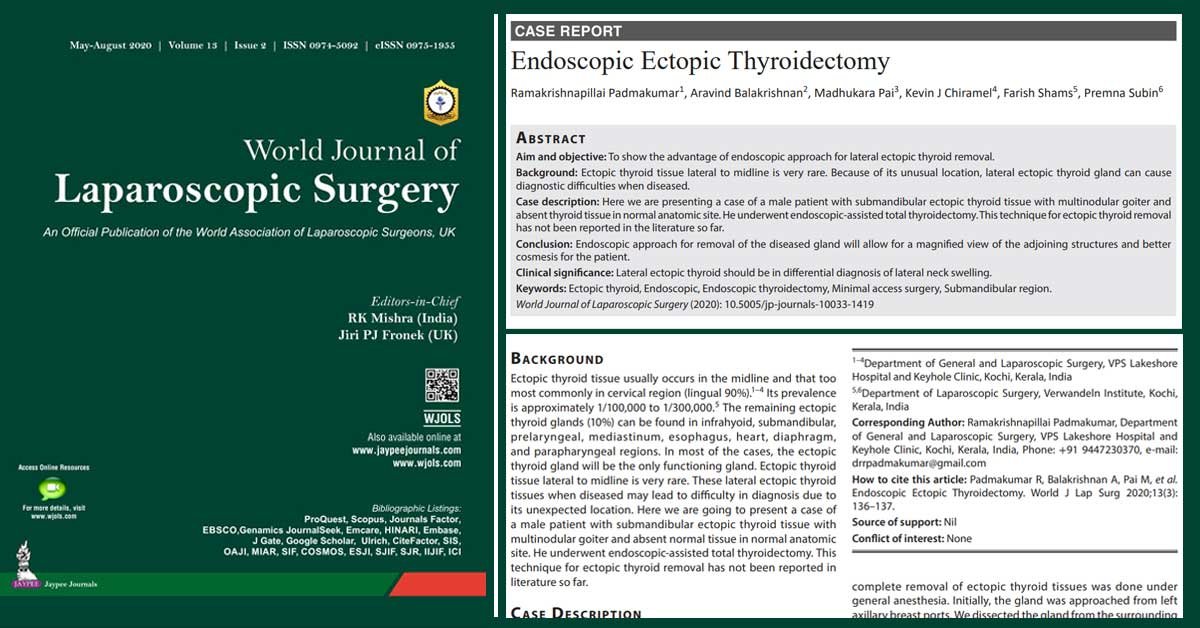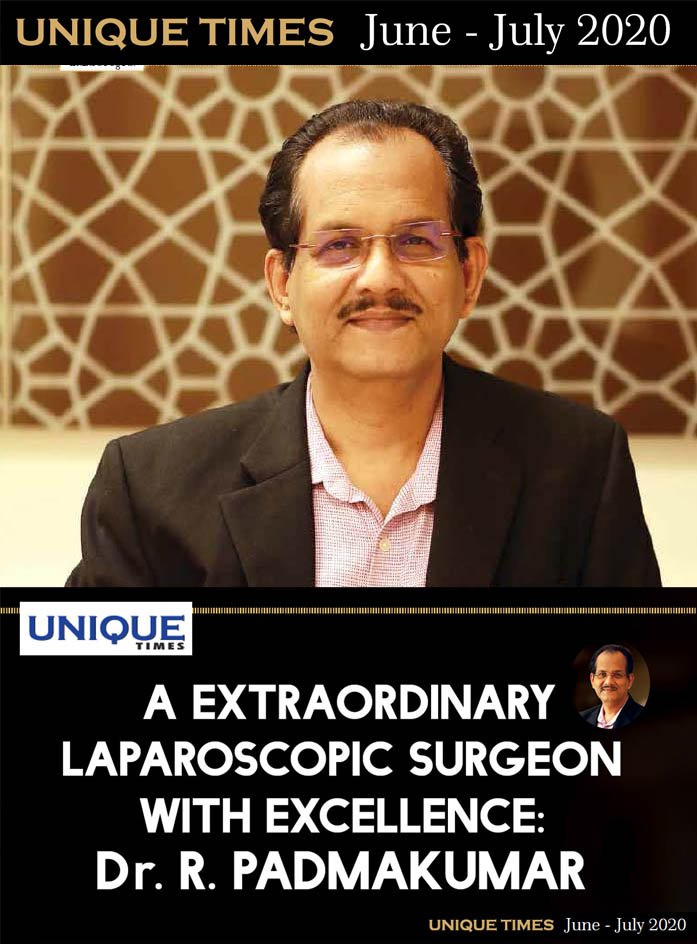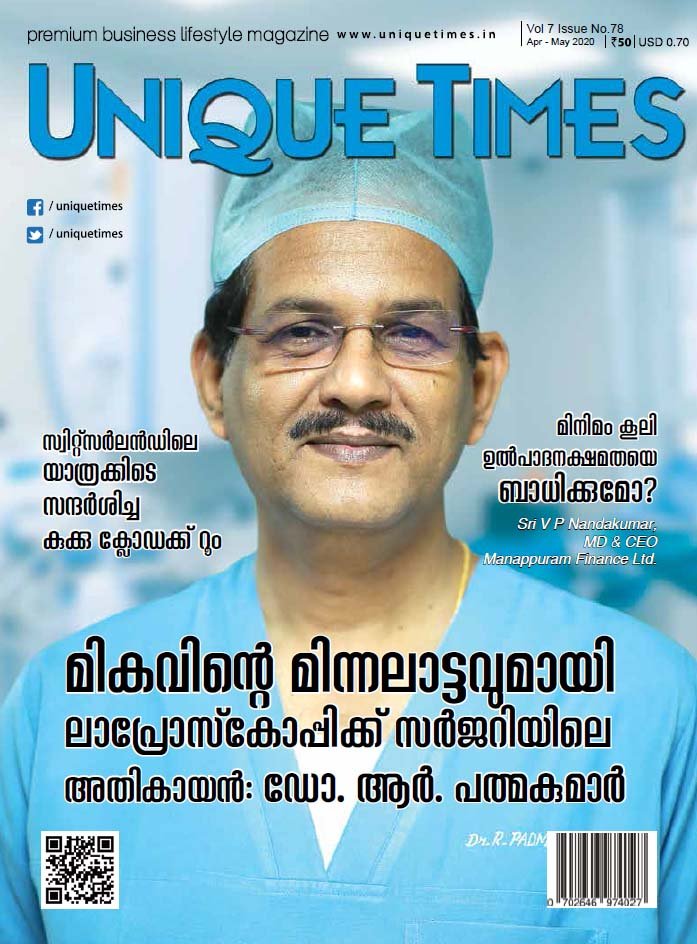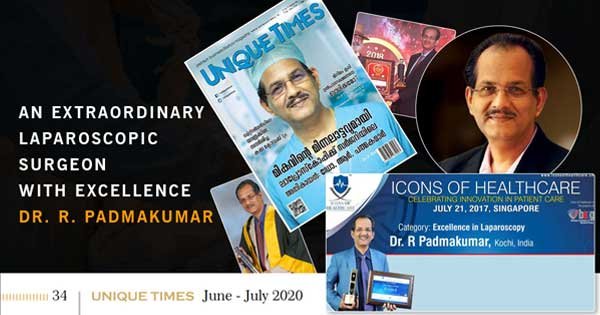Endoscopic Ectopic Thyroidectomy

Endoscopic Ectopic Thyroidectomy – available from: https://www.wjols.com/doi/WJOLS/pdf/10.5005/jp-journals-10033-1419
Ramakrishnapillai Padmakumar1, Aravind Balakrishnan2, Madhukara Pai3, Kevin J Chiramel4, Farish Shams5, Premna Subin6
Abstract
Aim and objective: To show the advantage of endoscopic approach for lateral ectopic thyroid removal.
Background: Ectopic thyroid tissue lateral to midline is very rare. Because of its unusual location, lateral ectopic thyroid gland can cause diagnostic difficulties when diseased.
Case description: Here we are presenting a case of a male patient with submandibular ectopic thyroid tissue with multinodular goiter and absent thyroid tissue in normal anatomic site. He underwent endoscopic-assisted total thyroidectomy (endoscopic thyroidectomy). This technique for ectopic thyroid removal has not been reported in the literature so far.
Conclusion: Endoscopic approach for removal of the diseased gland will allow for a magnified view of the adjoining structures and better cosmesis for the patient.
Clinical significance: Lateral ectopic thyroid should be in differential diagnosis of lateral neck swelling.
Keywords: Ectopic thyroid, Endoscopic, Endoscopic thyroidectomy, Minimal access surgery, Submandibular region, Endoscopic Ectopic Thyroidectomy.
Background
Ectopic thyroid tissue usually occurs in the midline and that too most commonly in cervical region (lingual 90%).1–4 Its prevalence is approximately 1/100,000 to 1/300,000.5 The remaining ectopic thyroid glands (10%) can be found in infrahyoid, submandibular, prelaryngeal, mediastinum, esophagus, heart, diaphragm, and parapharyngeal regions. In most of the cases, the ectopic thyroid gland will be the only functioning gland. Ectopic thyroid tissue lateral to midline is very rare. These lateral ectopic thyroid tissues when diseased may lead to difficulty in diagnosis due to its unexpected location. Here we are going to present a case of a male patient with submandibular ectopic thyroid tissue with multinodular goiter and absent normal tissue in normal anatomic site. He underwent endoscopic-assisted total thyroidectomy. This technique for ectopic thyroid removal has not been reported in literature so far.
Case Description
A 58-year-old male patient presented to our department with complaints of a swelling in the upper neck on left submandibular region for about 6 months.
It was associated with rapid increase in size. There were no other associated symptoms. On examination, a 5 × 3 cm painless swelling was noted in the left submandibular region. The lump was soft in consistency. Thyroid tissue was not palpable in the normal anatomical location (Fig. 1).
Ultrasonography revealed a well-circumscribed heterogeneously hyperechoic nodule in the left submandibular region with absent thyroid gland in the thyroid bed—possibly ectopic thyroid nodule. Fine-needle aspiration biopsy of the swelling was taken which revealed colloid goiter. Thyroid scintigraphy revealed an area of increased radionuclide uptake in the submandibular region and no radionuclide uptake was seen in the neck in the thyroid bed.
Preoperative thyroid hormones and biochemical tests were normal. As gland was enlarging rapidly in size, endoscopic-assisted complete removal of ectopic thyroid tissues was done under general anesthesia. Initially, the gland was approached from left axillary breast ports. We dissected the gland from the surrounding tissues by endoscopic method. For retrieval of specimen, we put a small skin incision in the submandibular region and the specimen was removed in toto (Fig. 2). This helped in significantly minimizing the scar in cervical region.
Postoperative period was uneventful, and he was discharged on third postoperative day. Thyroxine 100 μg was started, as there was no other functioning thyroid gland. Histopathology report showed
features consistent with multinodular colloid goiter.

Fig. 1: Extended neck showing submandibular ectopic thyroid gland

Fig. 2 – Ectopic thyroid in relation with surrounding structures
Discussion
Ectopic thyroid in the submandibular region was first described by Helidonis et al.6 They speculated that the ectopic thyroid has a parahyoid location and because of its dimension resembled a submandibular gland anomaly. Abnormalities of thyroid gland during embryologic development and migration may result in ectopic thyroid gland. Normally, migration of the thyroid gland is from the foramen cecum to the pretracheal position.7 In addition to normal migration pathway of the thyroid gland, ectopic thyroid tissue can be seen even in mediastinal, intracardiac, gastrointestinal, and intraperitoneal locations.4,8,9 Ectopic thyroid tissue is mostly (90%) localized in sublingual position.
Asymptomatic ectopic thyroid tissue may become symptomatic, particularly in the adolescence and pregnancy period due to increase in thyroid-stimulating hormone level and due to thyroid tissue hyperplasia.10,11 All diseases that involve thyroid tissue in its normal location can also involve ectopic thyroid tissue. The differential diagnosis should include thyroglossal duct cyst, hyperplastic lymphoid tissue, lymphangioma, fibroma, lipoma, dermoid cyst, squamous cell carcinoma, minor salivary gland tumor, lymphoma, and vascular tumors.12,13
Ultrasonography (USG), scintigraphy, computerized tomographic scan (CT), and magnetic resonance imaging (MRI) are the methods that can be used in the diagnosis. Thyroid scintigraphy is a sensitive and specific method in determining that thyroid gland is not in its normal location.13 USG and CT are beneficial in the diagnosis but have low sensitivity and specificity. In MRI, ectopic tissue is observed to be iso- or hyperintense compared to muscles. 13 In addition to imaging of the normal thyroid tissue, thyroid
scintigraphy is also important to show the functions of the lingual thyroid tissue. In our case, we performed USG followed by FNAC and then thyroid scintigraphy was performed for confirmation of our diagnosis. All the surgeries performed for lateral ectopic thyroid so far has been by open method. We performed an endoscopic assisted total thyroidectomy which has not been reported in literature so far. Endoscopic approach for removal of the diseased thyroid gland will give a magnified view of the adjoining structures and better cosmesis for the patient.
Conclusion
Lateral ectopic thyroid tissue is a very rare condition of which most common site is in submandibular location. Endoscopic approach for removal of the diseased ectopic gland has not been reported earlier. The procedure is very safe and gives a much better cosmetic outcome.
References
- Zieren J, Paul M, Scharfenberg M, et al. Submandibular ectopic thyroid gland. J Craniofac Surg 2006;17(6):1194–1198. DOI: 10.1097/01. scs.0000246502.69688.60.
- Choi JY, Kim JH. A case of an ectopic thyroid gland at the lateral neck masquerading as a metastatic papillary thyroid carcinoma. J Korean Med Sci 2008;23(3):548–550. DOI: 10.3346/jkms.2008.23.3.548.
- Huang TS, Chen HY. Dual thyroid ectopia with a normally located pretracheal thyroid gland: case report and literature review. Head Neck 2007;29(9):885–888. DOI: 10.1002/hed.20604.
- Aköz T, Erdogan B, Ayhan M, et al. Ectopic submandibular thyroid tissue. Rev Laryngol Otol Rhinol (Bord) 1998;119(5):323–325.
- Akanmu IN, Adewale OM. Lateral cervical ectopic thyroid masses with eutopic multinodular goiter: an unusual presentation. Hormones (Athens) 2009;8(2):150–153. DOI: 10.14310/horm.2002.1232.
- Helidonis E, Dokianakis G, Papazoglou G, et al. Ectopic thyroid gland in the submandibular region. J Laryngol Otol 1980;94(2):219–224. DOI: 10.1017/S0022215100088708.
- Yılmaz MS, Aytürk S, Güven M, et al. Submandibular ectopic thyroid with normally located thyroid gland. Kulak Burun Bogaz Ihtisas Derg 2014;24(1):50–53. DOI: 10.5606/kbbihtisas.2014.41713.
- Feller KU, Mavros A, Gaertner HJ. Ectopic submandibular thyroid tissue with a coexisting active and normally located thyroid gland: case report and review of literature. Oral Surg Oral Med Oral Pathol Oral Radiol Endod 2000;90(5):618–623. DOI: 10.1067/moe.2000.108804.
- Kanaya H, Tanigaito Y, Shyono N, et al. A rare case of ectopic, normally functioning thyroid tissue presenting as a left submandibular mass. Nippon Jibiinkoka Gakkai Kaiho 2005;108(9):850–853. DOI: 10.3950/jibiinkoka.108.850.
- Kurukahveciŏglu S, Arslan H, Kocatürk S, et al. Ectopic thyroid gland at infrahyoid localization: case report. Kulak Burun Bogaz Ihtis Derg 2007;15(2):87–90.
- Bersaneti JA, Silva RDP, Ramos RRN, et al. Ectopic thyroid presenting as a submandibular mass. Head and Neck Pathology 2011;5(1):63–66. DOI: 10.1007/s12105-010-0209-z.
- Prado H, Prado A, Castillo B. Lateral ectopic thyroid: a case diagnosed preoperatively. Ear, Nose Throat J 2012;91(4):E14–E18. DOI: 10.1177/014556131209100417.
- Çeliker M, Çeliker FB, Turan A, et al. Submandibular lateral ectopic thyroid tissue: ultrasonography, computed tomography, and scintigraphic findings. Case Rep Otolaryngol 2015;2015:769604. DOI:
10.1155/2015/769604.
1–4Department of General and Laparoscopic Surgery, VPS Lakeshore Hospital and Keyhole Clinic, Kochi, Kerala, India
5,6Department of Laparoscopic Surgery, Verwandeln Institute, Kochi, Kerala, India
Corresponding Author:
Ramakrishnapillai Padmakumar,
Department of General and Laparoscopic Surgery,
VPS Lakeshore Hospital and Keyhole Clinic, Kochi, Kerala, India,
Phone: +91 9447230370, e-mail: drrpadmakumar@gmail.com
How to cite this article:
Padmakumar R, Balakrishnan A, Pai M, et al. Endoscopic Ectopic Thyroidectomy. World J Lap Surg 2020;13(3): 136–137.
Source of support: Nil
Conflict of interest: None
About Dr. R. Padmakumar
Dr. R. Padmakumar is one of the Best Hernia Surgeon in India. He has been changing lives through Keyhole Surgery. He has got more than 30 years of hands-on experience in laparoscopic Surgery in major hospitals across India and has completed more than 7000 cases of Laparoscopic Hernia Surgeries. Dr. Padmakumar has trained more than 300 surgeons from all over the world the art of laparoscopic surgery especially Laparoscopic Hernia Surgery. Dr. Padmakumar is also hailed as one of the Best Bariatric Surgeon in India & UAE. He is renowned for new and improved treatment techniques and the first in the World to perform Scarless Bariatric Surgery with Tummy Tuck / Abdominoplasty. He is also one of the very few thyroid surgeons in India doing Endoscopic Thyroidectomy (scarless thyroid surgery).


-
Anal Fissure Treatment
-
Gynaecomastia Treatment
- Piles / Hemorrhoids Treatment
- Varicose Veins Treatment
- Laser Treatment for Varicose Veins
- Diabetic Foot Treatment







